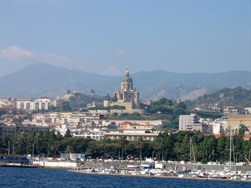Messina
 The first Greek colony in Sicily, Messina was founded in 756 B.C. Falling, over the centuries, under Roman, Byzantine, Arab, Norman, Swabian, Angevin, Aragonese and Spanish domination, the city contended for the title of capital of the kingdom of Sicily with Palermo and it was, thanks to its port, one of the greatest centers of commerce on the Mediterranean Sea. The long-standing rivalry with Palermo, also based on economic issues (Sicilian grain, represented by Palermo, as opposed to the Sicilian silk industry, led by Messina) lasted throughout the period of the Spanish viceroyalty. Between 1674 and 1678 the city rebelled against Spanish rule, being one step away from ending up under French rule. Several earthquakes have plagued the history of Messina: in particular, that of 1908, along with the subsequent tsunami, was responsible for about 80,000 deaths (out of a total population of 140,000) and irreparable damage to the artistic and cultural heritage of the city. Among the buildings destroyed was the first Jesuit college founded in Italy, in 1549, following the example of the one in Gandía and at the invitation of the viceroy Juan de Vega. It constituted a model for all subsequent colleges of the Society in Italy.
The first Greek colony in Sicily, Messina was founded in 756 B.C. Falling, over the centuries, under Roman, Byzantine, Arab, Norman, Swabian, Angevin, Aragonese and Spanish domination, the city contended for the title of capital of the kingdom of Sicily with Palermo and it was, thanks to its port, one of the greatest centers of commerce on the Mediterranean Sea. The long-standing rivalry with Palermo, also based on economic issues (Sicilian grain, represented by Palermo, as opposed to the Sicilian silk industry, led by Messina) lasted throughout the period of the Spanish viceroyalty. Between 1674 and 1678 the city rebelled against Spanish rule, being one step away from ending up under French rule. Several earthquakes have plagued the history of Messina: in particular, that of 1908, along with the subsequent tsunami, was responsible for about 80,000 deaths (out of a total population of 140,000) and irreparable damage to the artistic and cultural heritage of the city. Among the buildings destroyed was the first Jesuit college founded in Italy, in 1549, following the example of the one in Gandía and at the invitation of the viceroy Juan de Vega. It constituted a model for all subsequent colleges of the Society in Italy.
